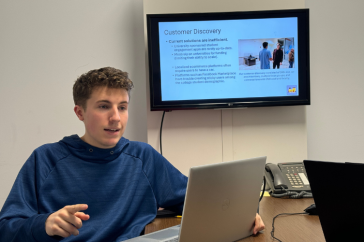When New Hampshire Secretary of State Phillip Carrigain set to work on creating the state’s first official map in 1805, he didn’t intend to create a piece of history — he simply wanted a useful administrative tool for the fledgling state. But the map, completed in 1816, turned out to be something special: a marvel of cartography and a work of art that, 200 years later, is still an impressive sight.
Now one of the extant copies of the map has found a home in the Dimond Library’s special collection. University librarians purchased a copy of the map this fall, and the university community will be able to see it up close on Wednesday, Nov. 16.

Phillip Carrigain’s historic map of New Hampshire
With detailed depictions of the White Mountains, etchings of geological landmarks and a wealth of information about life in early 19th-century New Hampshire, “This is a map you have to be awed by,” says Hannah Hamalainen, geospatial and Earth sciences librarian.
When Carrigain began his tenure as secretary of state in 1805, New Hampshire didn’t have an official map. Town boundaries were in dispute, and much of the North Country and the White Mountains region hadn’t been surveyed.
Legislators required every town to submit a map of its boundaries, roads and natural features. Carrigain was in charge of collecting the data and piecing it together. The whole process was supposed to take only two years; instead, it took more than a decade.
“You see the cartographic etchings of geological features engraved within the inset of the map, and it just wows you,” Hamalainen says. “The quality of detail is amazing. It shows specific ranges in the White Mountains … and it does a great deal more than just give administrative boundaries.”
The map is 5 feet tall and about 3.5 feet wide. Study the map and you’ll see a snapshot of what life was like in New Hampshire in the early 1800s — the major roads, number of homes, public buildings and churches in each community — even notations about the judges who presided over the local court. The map is equally as concerned with the state’s natural beauty. In its introductory text, the map declares New Hampshire’s “lakes, cataracts and valleys furnishes a profusion of the sublime and beautiful. It may be called the Switzerland of America.”
“It really is a beautiful example of mapmaking,” says professor Bill Ross, special collections librarian. “It’s not only a really fine map of New Hampshire, but it places New Hampshire in the context of the rest of the country at the time.”
According to an article in the journal Historical New Hampshire, 250 copies of the map were printed in 1816. Only 25 copies of the map are available for viewing in libraries across the country, Ross says, and it is unclear how many copies are in private collections.
At UNH, a number of small endowments helped fund the purchase of the map. “As a flagship university, it’s imperative for us to have a historical map like this — that allows us to get a better understanding of New Hampshire’s history,” Hamalainen says. “This is something we can use in our classes, so that students can understand the history of cartography and how it played a role in establishing legislation and legal boundaries.”
Although the map can be found online, seeing it up close is a special experience, Hamalainen says. The map will be on display on Wednesday, Nov. 16, for GIS Day, an international celebration of geographic information systems technology. Ross says there are ongoing discussions about a “semi-permanent display” for the map, but until then, it will only available to view in the special collections room.
Even in the era of Google Maps, Hamalainen believes documents like the Carrigain map provide a vital window to the past.
“For historians or people interested in nature writing or knowing more about the natural resources around us, this is a great resource. I think it’s a little romantic to think about how — when the map was made — largely undiscovered that area was, what amount of wilderness was there before, how it’s changed and what it’s like today,” Hamalainen adds.
Find out more about GIS Day at UNH
-
Written By:
Larry Clow '12G | UNH Cooperative Extension

















































